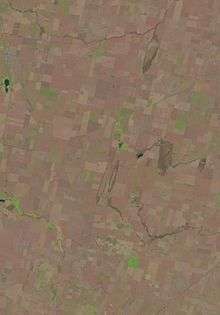Rio Cuarto craters
The Río Cuarto craters are a purported group of impact craters located in Córdoba Province, Argentina.[1] However, they have also been considered as just a result of Aeolian processes.[2][3]
Discovery
In 1990, Captain Ruben Lianza of the Argentine Air Force, an amateur astronomer, provided a report to an astronomy publication that included aerial pictures of a set of odd teardrop-shaped depressions near the city of Río Cuarto, Córdoba in north-central Argentina. The depressions seemed very similar to the sets of craters produced in laboratory simulations of impacts taking place at low angles. Such features exist on the Moon, Mars, and Venus, but had not been seen on Earth up to that time.
The depressions had long been known to Argentine geologists, but until Lianza, nobody had seriously investigated them. Samples of materials obtained from the depressions indicated the presence of shocked materials, as well as pebbles that were clearly of meteoritic origin. A team of American researchers went to Argentina to investigate, collaborating with Captain Lianza and Argentine academics to study the strange depressions.
There were ten depressions, four of them of substantial size. One crater, named the "Drop", was about 200 meters wide and 600 meters long. Two more large craters, the "Eastern Twin" and "Western Twin", both about 700 meters wide and 3.5 kilometers long, were located 5 kilometers to the northeast. Another major crater, the "Northern Basin", about half and again as big as one of the Twins, was sited 11 kilometers further to the northeast. The long axes of the craters all pointed to the northeast.
Formation

The craters were thought to be due to a grazing impact of a set of objects at a very low angle, which calculations show to be a rare occurrence. Most impacts will strike at an angle of 45 degrees to the horizontal or greater, and the impact craters will always be close to circular, since the shock wave that results from the impact propagates symmetrically.
A grazing impact, however, will form an elliptical crater, with sprays of debris that look like butterfly wings. This has been confirmed by high-velocity guns used for impact experiments, and more recently by computer simulations. On impact, the object may shed chunks of itself that fly further downrange to perform secondary impacts.
Models of the Río Cuarto event suggest that the object struck at an angle of no more than 15 degrees from the horizontal, with the impact itself having 10 times more explosive energy than the Barringer Crater event and 30 times more than the Tunguska event. Although the age of the craters has not yet been determined precisely, it is believed by some researchers they are about 10,000 years old, placing them at the start of the Holocene, though the EID gives a broader age of less than 100,000 years old.[1]
Non impact formation
Satellite surveys of the area have found more than 400 similar oval features in the area, and studies of the layers of rock show no evidence of raised rims. These studies point to the oval features as being dune formations, aligned to the prevailing northeast wind.[3]
There is no doubt that there is impact material in the form of glassy impactite and shocked quartz in the Rio Cuarto structures. The age of this material has been questioned, and estimated to more than 500,000 BP, from an unknown source crater. There may have been a second, more recent event at around 10,000 BP which produced a second layer of impactite glass.[3]
Effects
The object came in from the northeast, as bright as the Sun. The object hit ground at the Northern Basin, creating a mountain of fire about 10 kilometers wide and 50 kilometers long, and scattered off pieces that went downrange to form the Twins and the Drop. The fireball incinerated all life downrange in a firestorm with a parabolic-shaped footprint that created hurricane-force winds, erasing the butterfly-shaped pattern of debris characteristic of such low-angle strikes.
The object was thought to be a "carbonaceous chondritic" asteroid, largely made up of simple carbon compounds and resembling something like a big lump of soot. The impact probably released huge clouds of toxic carbon monoxide that killed off wildlife in the area, assisted by heavy concentrations of toxic nitric oxides created through ionization by the object's fiery passage through the atmosphere. It is likely the impact resulted in serious atmospheric effects and may have even had a short-term effect on global climate.
References
- 1 2 "Rio Cuarto". Earth Impact Database. University of New Brunswick. Retrieved 2009-08-19.
- ↑ Cione, Alberto L. et al. (2002). Putative Meteoritic Craters in Río Cuarto (Central Argentina) Interpreted as Eolian Structures, Earth, Moon, and Planets 91 (1), 9-24.
- 1 2 3 Acevedo, Daniel; Rocca, Maximiliano C. L.; Ocampo, Adriana C. (September 2011). "Meteorite Impact Craters in South America: A Brief Review". Retrieved 18 September 2016.
Coordinates: 32°52.7′S 64°13.4′W / 32.8783°S 64.2233°W

